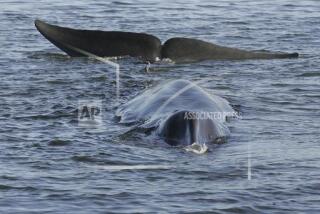Early Whale Population Undercounted, Study Says
- Share via
Before they were harpooned, sliced up and boiled for lamp oil, whales were far more plentiful in the North Atlantic than previously thought, according to new genetic analysis that could thwart any attempt to resume commercial whaling for half a century or more.
For years, scientists have worked to determine what the population of whales was before the onslaught of commercial whaling. The population figures matter because a ban on commercial whaling that began in 1986 is to remain in effect until whale populations rebound to more than half of those pre-hunting levels.
Despite being as big as buses, whales are difficult to count. They are scattered over wide areas of all the oceans. They swim great distances to feed and breed, and are hard to track as they dive below the water’s surface.
Until now, the best evidence for calculating historic whale populations came from painstaking efforts to sift through the logbooks of old whaling ships from the 17th through most of the 20th century.
The new study, published in today’s issue of the journal Science, marks the first time that scientists have applied sophisticated genetic tools to determine how many whales once roamed the oceans.
Looking at telltale genetic variations that increase with population size, Stanford geneticist Stephen R. Palumbi and his former graduate student Joe Roman at Harvard determined that 240,000 humpback, 360,000 fin and 265,000 minke whales roamed the North Atlantic.
By contrast, there are now about 10,000 humpback, 56,000 fin and 149,000 minke whales in the North Atlantic, researchers said.
The estimates from the genetic study are much higher than those derived from the logbooks. That already has stirred a debate among scientists affiliated with the International Whaling Commission, which tries to manage whaling. The commission’s regulations are based on the lower estimates of historic populations derived by the logbook method.
Under the commission’s rules, the current “pause” on commercial whaling would remain in effect until certain types of whales have reached 54% of their pre-exploited populations.
“Everyone knows that whales have been decimated, and there’s an attempt to bring their populations back,” Palumbi said. “The question is, ‘Bring them back to what?’
“If you believe the logbook numbers, then the populations of some whales will be up to exploitable levels before the next presidential election,” he said. “If these genetic numbers are correct, we are far from succeeding at bringing them back close to the status of what they were in the past. It will take another 50 or 100 years of protection.”
Palumbi’s study is the latest in a series of scientific reports that indicate marine life was far more abundant before widespread human hunting than had been realized by present-day scientists.
Palumbi and Roman picked humpback, fin and minke whales in the North Atlantic because scientists have a larger database of genetic material for those species than any other.
They looked at DNA found in cell structures called mitochondria. Unlike most DNA, the genetic material in the mitochondria is passed down virtually unchanged to offspring.
Tiny mutations in that DNA accumulate slowly over time. As a result, how much the mitochondrial DNA in one whale differs from that of another indicates how many generations have passed since the two had a common ancestor. That, in turn, lets scientists estimate the size of the ancestral population.
“We were surprised at the genetic diversity,” Roman said. The variations in genetic sequences, he said, were far too high to support the pre-whaling population estimates based on ships’ logs.
“Whaling logbooks provide clues, but may be incomplete, intentionally underreported, or fail to consider whales that were struck and lost,” Roman and Palumbi wrote in their article. They called for reconciling their genetic-based population estimates with those pieced together from whaling records.
Scientists who have studied whale populations using the logbook method questioned the study’s methods and results.
Tim Smith, a government fisheries biologist in Woods Hole, Mass., and head of the U.S. scientific delegation to the International Whaling Commission, said data from the ship logbooks are much better than the study said. The figures have been carefully cross-checked, he said.
“The population of humpbacks could not have been greater than 40,000 based on historical data and was probably substantially less than 40,000,” Smith said. “Their estimate of 240,000 cannot be true. They just don’t understand.”
Furthermore, he said, the geneticists are meddling in a politically charged arena. “They want to give advice and that is extremely volatile,” Smith said. “The result is a paper with unproven methodology that doesn’t serve science well, and doesn’t serve fisheries management well.”
Indeed, the decision of whether to resume commercial whaling isn’t likely to turn solely on science. The International Whaling Commission is a hotly charged political body. Anti-whaling nations, led by the U.S., have managed to continue a ban on commercial whaling for 17 years. The IWC has refused to officially sanction commercial whaling by Norway and Japan.
Norway this year plans to catch between 600 and 700 minke whales, ignoring the IWC’s ban on commercial whaling. Japan is expected to catch about 750 whales for what it calls research, a recognized exemption to the ban under IWC rules.
Unlike in past centuries, whales are not hunted by those countries for their rich oil once used in lamps, soaps and perfumes. Instead, their meat is sold in Japanese restaurants and in stores as sashimi, whale bacon and dark-reddish steaks.
Alan Macnow, a New York-based consultant for the Japan Whaling Assn., said Japan and other nations are always suspicious of certain U.S. scientists. “We always have questions about Palumbi and his friends,” he said.
Japan and other nations that “support sustainable use of whales” have science on their side of the debate, he said, adding that minke whales, in particular, are abundant enough to justify resumption of commercial whaling.
Indeed, Palumbi, a marine ecologist who recently moved from Harvard to Stanford’s Hopkins Marine Station, has bedeviled Japanese whaling interests in the past with his DNA detective work.
In the 1990s, he and other researchers set up a clandestine DNA lab in a Tokyo hotel that helped determine that some whale meat sold in Japanese restaurants and markets came from endangered whales.
Another DNA fingerprinting project showed that half of the samples of “whale” meat sold in Japanese markets was actually dolphin or porpoise that contained dangerously high levels of mercury and other contaminants.
More to Read
Sign up for Essential California
The most important California stories and recommendations in your inbox every morning.
You may occasionally receive promotional content from the Los Angeles Times.










